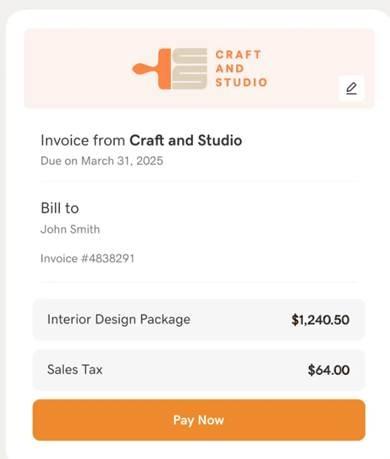Sales tax is part of nearly every transaction in the U.S., but figuring out how to calculate it can be tricky. Rates vary from state to state, some cities add their own rules, and selling online can complicate things even further. For business owners, understanding how to calculate sales tax helps you stay compliant, avoid mistakes, and keep customers confident in their purchases. Let’s dive into everything you need to know about calculating sales tax to help your business thrive.
Related: Ways to accept payments on a website
What is sales tax?
Sales tax is a percentage fee added to the price of goods and services at the point of purchase. It’s imposed by state and local governments and collected by businesses on their behalf. The revenue from sales tax helps fund public services like schools, roads, and community programs.
In most cases, sales tax applies to physical products, but many states also include services such as repairs, personal care, or digital downloads. If your business sells taxable items, you’re responsible for calculating and adding the correct amount to the total cost.
It’s important to know how sales tax works when you write a receipt so customers can clearly see the breakdown of what they’re paying.
Who collects sales tax?
Businesses are responsible for collecting sales tax at the point of sale and then remitting it to the proper state or local agency. This applies to both in-person and online transactions. For example:
- Retailers: Add sales tax to in-store purchases and keep records of what was collected.
- Online sellers: Charge the correct tax rate for customer locations.
- Marketplace facilitators: Platforms like Amazon or Etsy often handle collection and remittance on behalf of their sellers.
Tools like the GoDaddy Online Store make this easier by letting you set sales tax rates by country or region and, in some cases, by state or province. You can also set up taxes manually or use automated tax rules by ZIP code to streamline the process.
Sales tax nexus
A sales tax nexus is the legal connection between your business and a state that requires you to collect and remit sales tax there. Essentially, if your business has a nexus in a state, you must follow that state’s tax laws. How you establish a nexus depends on your state, but the most common methods are:
- Physical presence, such as an office, store, or warehouse
- Hiring employees or contractors in a state
- Reaching economic thresholds (like $100,000 in sales or 200 transactions annually)
- Selling through trade shows or events in a state
Sales tax vs. value-added tax
Sales tax and value-added tax (VAT) are both consumption taxes—what governments use to raise revenue from consumer purchases—but they operate differently. In the United States, sales tax is the standard. It’s charged once at the final point of sale, meaning only the end customer pays it. Businesses collect the tax, add it to the purchase price, and then remit it to the state or local authority.
VAT is more common outside the U.S. Instead of being applied only at checkout, it’s charged at each stage of the supply chain. For example, a manufacturer pays VAT on raw materials, a wholesaler pays VAT on the manufacturer’s goods, and a retailer pays VAT on the wholesaler’s price. Each business can usually reclaim the VAT they’ve already paid, so the tax ultimately falls on the end consumer, but it’s tracked throughout the process.
| Sales tax | Value-added tax (VAT) |
|---|---|
| Applied only once, at the point of sale to the final consumer | Applied at each step of production and distribution |
| Common in the U.S. | Widely used in Europe, Canada, and many other regions |
| Collected and remitted by the retailer | Collected and remitted by every business in the supply chain |
| No input tax credit for businesses | Businesses reclaim VAT on their inputs and only remit the difference |
How to calculate your sales tax
Sales tax doesn’t have to be complicated. Once you know the formula, you can quickly add the right amount at checkout or work backward if you only have the total price. Below are the steps for calculating sales tax, reverse-calculating sales tax, and two sales tax calculators that can help make your job easier.
Sales tax formula explained
The sales tax formula is simple:
Sales tax = item price × sales tax rate
For example:
- Item price: $75
- Sales tax rate: 7% (0.07 in decimal form)
- $75 × 0.07 = $5.25 sales tax
- Total = $75 + $5.25 = $80.25
Sales tax calculator
Not a fan of crunching numbers by hand? Use the calculator below. Just enter your product price and tax percentage, then click calculate total to instantly see the final amount.
Sales Tax Calculator
How to calculate tax from the total amount
Sometimes you only know the total price a customer paid, and you need to figure out how much of that was sales tax. You can do this through reverse calculation. This may sound tricky, but all you have to do is work backward. Here’s how:
- Divide the total price by 1 + the tax rate (in decimal form).
- The result is your pre-tax price.
- Subtract the pre-tax price from the total to get the sales tax.
Let’s say a customer’s receipt shows $212 total in an area with an 8% sales tax rate.
- 212 ÷ 1.08 = $196.30 pre-tax
- 212 – 196.30 = $15.70 tax
Reverse sales tax calculator
To make things easier, use the reverse sales tax calculator below. Enter the total price and the sales tax percentage, then click calculate to get both the pre-tax amount and the tax itself.
Reverse Sales Tax Calculator
Real-world examples: Basic and complex scenarios
Sales tax isn’t the same everywhere. Some states stick with a flat rate, while others add city or county taxes. In others, certain items are exempt from sales tax altogether.
| Location | Sales Tax Scenario | Item Price | Sales Tax Rate | Sales Tax Amount | Final Total |
|---|---|---|---|---|---|
| Florida | Flat rate | $120 | 6% | $7.20 | $127.20 |
| Cook County, Illinois | State and local sales taxes | $50 | 8% | $4.00 | $54.00 |
| New York City | Mixed rules | $200 ($100 taxable) | 8.5% | $8.50 | $208.50 |
Sales tax rates are used above as an example and are current at the time of publishing.
Example 1: Flat state rate (Florida)
Florida applies one statewide rate, with no additional local sales taxes. This makes calculating sales tax easy.
- Item price: $120
- State sales tax: 6%
- Tax: $120 × 0.06 = $7.20
- Total = $127.20
Example 2: State + local taxes (Cook County, Illinois)
In Illinois, counties and cities can add their own sales taxes on top of the state’s base rate. Cook County, for example, adds 1.75% to the state’s 6.25%.
- Item price: $50
- State rate: 6.25%
- County rate: 1.75%
- Combined rate: 8%
- Tax: $50 × 0.08 = $4.00
- Total = $54.00
Example 3: Mixed rules (New York City)
Some states exempt certain essential items from sales tax, but still tax other goods. In New York City, groceries are exempt, but clothing is taxed at a combined state and local rate of 8.5%.
- $100 groceries (exempt)
- $100 clothing (taxable at 8.5% combined)
- Clothing tax: $100 × 0.085 = $8.50
- Total = $208.50
When you need to add sales tax
Not every product or service is taxed, but most businesses will run into situations where sales tax applies. Knowing when to add it helps you stay compliant and avoid surprises during tax season.
Sales tax rules vary by location, but it is typically applied to:
- Physical goods: Clothing, electronics, furniture, and other tangible items
- Digital goods: Downloadable software, e-books, and streaming subscriptions (varies by state)
- Services: Repairs, personal care, and professional services in states that tax labor
- Prepared food and beverages: Restaurant meals, catering, and takeout orders
- Event tickets and admissions: Concerts, sporting events, and other paid entry events
Related: Filing business taxes for an LLC
State tax exemptions
Sales tax exemptions are rules that exclude certain products, services, or buyers from being taxed. States create these exemptions to reduce costs on essentials, support specific industries, or help nonprofit organizations. Common exemptions include:
- Groceries: Basic food items are often exempt in states like Texas and Florida.
- Prescription medicines: Almost always exempt across the U.S.
- Resale goods: Products purchased for resale can be exempt if the buyer has a resale certificate.
- Nonprofits: Charitable or religious organizations may be exempt from paying sales tax.
Let’s look at a few examples of sales tax exemptions in different states:
- New York: Groceries are exempt, but candy and soda are taxable.
- Minnesota: Clothing is exempt, but accessories like handbags are taxable.
- California: Prescription drugs are exempt, but over-the-counter medicine is taxable.
- Texas: Nonprofits with a state-issued exemption certificate can avoid sales tax on qualifying purchases.
To determine which of your services and products are taxable and which are exempt, visit your state’s Department of Revenue website or your local government’s tax office website.
State and local sales taxes
Because sales tax rules vary by location, the sales tax rate isn’t the same across the U.S., or even within a specific state’s borders. That means two customers buying the same item in the same state could pay different totals, depending on where they live. Below are some examples of state and local sales taxes in action.
| State | Locality | State sales tax rate | Local sales tax rate | Combined sales tax rate |
|---|---|---|---|---|
| California | Los Angeles County | 7.25% | 2.25% | 9.50% |
| California | Orange County | 7.25% | 0.50% | 7.75% |
| Texas | Austin (Travis County) | 6.25% | 2.00% | 8.25% |
| Texas | San Antonio (Bexar County) | 6.25% | 1.75% | 8.00% |
| New York | New York City | 4.00% | 4.50% | 8.50% |
| New York | Albany County | 4.00% | 4.00% | 8.00% |
States with no sales tax
There are currently four states that do not charge sales tax at all:
- Delaware
- Montana
- New Hampshire
- Oregon
Alaska does not have a statewide sales tax. However, some localities do. Always check with your state’s tax authority for the most accurate information.
Local sales taxes
Many states allow cities and counties to set their own sales tax rates. Local sales taxes are usually combined with state sales taxes to create the final total that a customer pays. Here’s a look at how the same $100 purchase can cost different amounts depending on your location:
| Location | State Sales Tax Rate | Local Sales Tax Rate | Combined Sales Tax Rate on $100 Purchase |
|---|---|---|---|
| Denver, Colorado | 2.90% | 6.41% | $9.31 ($109.31 total) |
| New Orleans, Louisiana | 4.45% | 5.50% | $9.95 ($109.95 total) |
| Tulsa, Oklahoma | 4.50% | 4.00% | $8.50 ($108.50 total) |
Common mistakes when calculating sales tax
Calculating sales tax isn’t complex, but it’s easy to overlook small details. Fortunately, most errors can be avoided by using tools that automatically apply the right rates, like when you create an invoice with GoDaddy Invoicing or run sales through a POS system.

Using incorrect rates
One of the most common errors is applying the wrong tax rate. This often happens when a business relies on outdated numbers, especially in states where local governments frequently change their rates. Using an incorrect rate can lead to undercharging and owing money out of pocket, or overcharging and frustrating customers.
To avoid this, check your state’s Department of Revenue site regularly for sales tax updates. You can also use automated sales tax tools built into ecommerce platforms and POS systems. If you’re selling across state lines, confirm the tax rules for every location where you have a nexus.
Overlooking shipping and handling
Another area that causes confusion is whether shipping and handling charges are taxable. In many states, shipping costs for tangible goods are considered part of the sale and must be taxed. Other states exempt shipping, but still tax handling fees. For instance:
- A customer in Ohio buys a $100 product with $10 shipping. Ohio taxes both the product and the shipping cost, so the 5.75% sales tax applies to $110. That adds $6.33 in tax.
- In Virginia, shipping charges are exempt as long as they’re listed separately on the invoice. In this case, tax would apply only to the $100 product, not the $10 shipping.
Always check the rules for your state before applying sales tax to shipping and handling costs.
Failing to track local tax rules
Local city and county taxes can change frequently, and missing these adjustments can throw off your calculations. To prevent local sales tax issues, subscribe to your state or local revenue department’s tax updates and use software or tools that apply taxes based on ZIP code. You should also regularly audit your sales records to make sure you’re charging the correct combined rate.
Master sales tax with the right tools
Calculating sales tax may feel complicated at first, but once you understand the basics, it becomes much easier to manage. Instead of tracking every rule on your own, you can save time by using tools that automatically apply the right rates, like GoDaddy POS systems.
Whether you’re ringing up sales in person or online, GoDaddy has built-in features to make tax collection simple.
Frequently Asked Questions
What is an example of sales tax?
Sales tax is the extra percentage added to a purchase at checkout. For example, if you sell a $50 jacket in a state with a 6% sales tax rate, you would charge an extra $3 in tax. The customer’s final total would be $53.
How do you divide the tax from a total?
If you only know the total price (with tax included), you can work backward to find the pre-tax amount and the tax itself. Follow these steps:
- Convert the sales tax rate to a decimal (for 8%, use 0.08).
- Add 1 to the rate (1 + 0.08 = 1.08).
- Divide the total price by this number. The result is the pre-tax price.
- Subtract the pre-tax price from the total to see the tax amount.
How do I charge for sales tax?
To charge sales tax, you need to know:
- Where the sale takes place (state and local rules)
- Whether the item or service is taxable
- The current sales tax rate for that location
Once you know the rate, apply it to the product price and add it to the customer’s total.
Disclaimer: This content should not be construed as legal or tax advice. Always consult an attorney or tax professional regarding your specific legal or tax situation.







